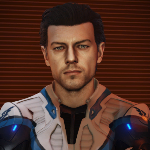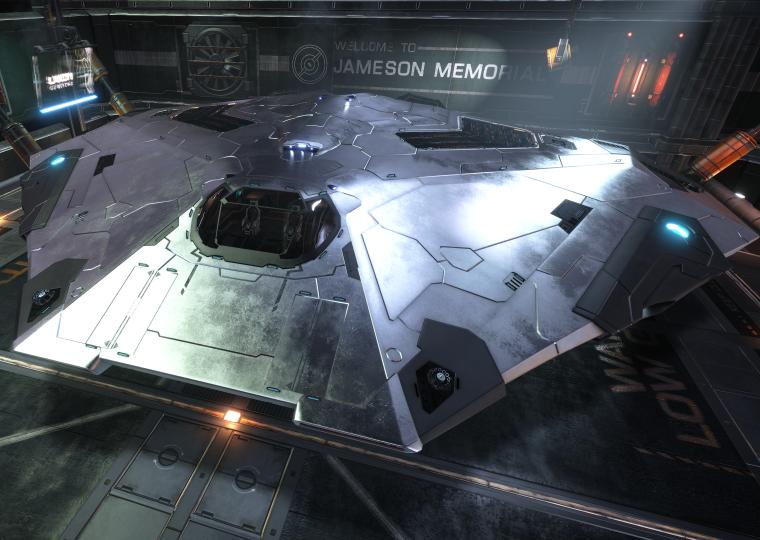CMDR Watcher profile > Logbook

(Cobra Mk III)

Back at the carrier after my short stay away. Nothing of too much interest to report, some Terraforables and Water Worlds scanned, a few Gas Giants with life, more instances of the seemingly ubiquitus Bark Mounds. Still, some nice views along the way.
I'll continue to work my way around the nebula and get as much scanned as possible, though I can't imagine I'll catch everything, there are plenty of stars.
At somepoint I'll have to make the journey down to the White Dwarf clusters and see what is going on with that. Not today though.
Ongoing exploration in and around the nebula today. Nothing hugely of note except for the fact that I've parked up for the day in a nearby system to continue mapping tomorrow rather than returning to the Smilers Observatory. This leaves me feeling a little uncomfortable, which is odd given the months I've spent in the deep void previously without carrier support or any other port nearby. I remember helping with the construction of Explorer's Anchorage and being very grateful to have a friendly port at the core as a base of operations. The DSSA shifts perspectives again, with a potential refuge never quite so far away again. This a good thing for commanders and the wider community but do we lose something by the galaxy becoming perhaps that little bit more civilised and a little bit smaller.
Meanwhile I'm not convinced the maintainence crew had anythign to do with yesterday 'glitch'. So, appologies to the SOs engineers. I now rather suspect mischief from my own crew. Haley and Louisa are consumate professionals and help considerably in combat but, I suspect, might be getting a bit bored. We'll have to have some flight exercises before long.
Just the one system today (Phleedgoe MY-G d11-51), a class A star with a binary companion K star.
This system has 14 planetary bodies, half of which are terraformable. Not a bad count. There a number of moons, some of which are landable, one with geo sites and a couple sporting bio signs. Exploration of one of these (A 3 A) showed more Bark Mounds. Sample collection yielded some Polonium which was rather handy.
SRV deployment had some difficulties with the ship ultimately excuting a dismiss maneouver and leaving me several km off station. This was rather alarming and I was glad to have the Destiny's Edge 2 return and land safely nearby. I'll have to have words with the maintenence crew on Smilers Observatory, I wouldn't expect any problems given the regular tuning up the ship has been receiving and I have a suspicion someone has been getting bored and playful.
One water world in the system amongst the terraformables. Interestingly this had been scanned and mapped by another commander, something not true of the other bodies.
Further exploration today, mostly focussing on the local class O stars around Smilers Observatory. Not very many of these in fact but at one of these a lonely landable planet was found on which Anemones grow (Phleedgoe DL-Y g1046). I landed, took samples and scans and moved on.
At some of the intervenening stars I found more Bark Mounds. Plenty of these at the nebula.
I few terraformable worlds but nothing much else of note. Did come across some more ringed gas giants but after yesterdays find I didn't feel lightening was likely to strike twice. Perhaps a mistake.
Anyway, I'm keen to see if there are other forms of life nearby so this currently takes priority and so my explorations will continue.
An interesting day.
I had two objectives for today's explorations. The first to continue my investigation in to local life in and around the nebula and, while doing so, to keep an eye out for good Tritium mining spots from which the Smilers Observatory and any other passing Fleet Carrier could refuel.
To the first of these objectives I was delighted to add the addition of Anemones to the local catalogue of life. I can confirm their presence on (Phleedgoe UJ-Q e5-54 2), having taken the ship down to investigate, though they may be present on other bodies within the system that also exhibit bio signal sources.
In investigating the Anemones I was breaking my usual rule against landing on 'high' G worlds. This planet sported gravity of about 2.23g, which is not high in the scheme of things but I typically avoid anything over 1g. Frankly I hate the feel of gravity dragging at my bones and prefer the weightlessness of space, or the low g of a small moon. Still, for the sake of science and exploration needs must. So I brought Destiny's Edge 2 in at a very shallow an cautious angle and approached the site. No pancaking in to the ground but I had to be very cautious with thrusters. The area in around the Anemones was rough, rocky terrain. Not a good place to try and land at the best of times but worse in high-G and in a larger ship like the Anaconda. Still, after much careful maneuvering and much thankfulness for the shields I got the ship down safely.
These Anemones are huge, fascinating entities and I took a few samples and scans and lots of pictures. I have to wonder how prevalent these are within this system and more widely in around the nebula. Hopefully I can find some other likely candidate systems, preferably with lower G worlds. Will I find other examples of life beyond the Bark Mounds and the Anemones I've found so far?
Lifting off from Phleedgoe UJ-Q e5-54 2 was a slow affair, the thrusters straining against the gravity and lifting the ship slowly up from the surface and out from the gravity well. I think the Destiny's Edge 2 was glad to be back in space too.
After this adventure I returned to the Smilers Observatory where I headed out with CMDR Smiler to try and fulfill that refueling objective. We scouted a few systems together before splitting up to cover more ground. Smiler found a likely candidate while I had limited luck at first. Then I hit the motherlode... Sheesh. In the system Phleedgoe EL-Y B46-9 I found three gas giants, two with rings and a further icy body with rings. The first of these giants, Phleedgoe EL-Y B46-9 A 1, had an extensive ring system. When mapped this ring system was positively glowing with hotspots all over. Void Opals (7), Low Temperature Diamonds (just the 1), Tritium (5) and a few other things besides. Of the Tritium hot spots two of the large spots were virtually coincident such that they looked like one large spot. At only 11.23Ly from the Smilers Observatory this was a far better find than I'd expected to make. Passing carriers will definitely have a good spot to refuel and if you have space for some space left over filling the rest with VOs and LTDs shouldn't be a problem. Almost sorry I didn't pack a refinery.
CMDR Smiler joined me to fully map the system and, apart from mining, we may pop back to explore the extensive geo sites that are also in the system.
Today I returned to the Phleedgoe NY-G d11-108 system and performed a brief survey of the remaining moons of the Class IV gas giant. On each of these I discovered more Bark Mounds, along with some pretty views. I also note geo sites on the second moon, I don't recall seeing these in the inital scanning yesterday so something of a surprise.
Back to new systems and further exploration tomorrow with any luck.
For future reference I note a cluster of White Dwarfs and Neutron Stars about 600Ly 'south' of the Smilers Observatory's position. This will require investigation in due course but there was insufficient time for this on todays excusions.
Today I visited a single Class F star (Phleedgoe NY-G d11-108) that none the less proved of interest. No Earth likes but I did discover a class IV gas giant with six moons, all landable, all sporting bio signals. One additionally had many geo signals. The class IV forming a binary pair with another gas giant, this one also sporting life. Of the latter item I'm not unfamiliar but I'm not sure I've seen such abundence of bio signal sources before.
I've only had a chance to land and investigate one of this sources, on the nearest moon of the gas giant. These turned out to be Bark Mounds again (perhaps all life in this area is of the same type?) and helpfully offered the opportunity to impove my stocks of Polonium.
All being well I'll return to this system tomorrow and complete mapping the moons and perhaps land at a few more sites.
Delighted to note that the Smilers Observatory has now deployed as part of the DSSA network at PHLEEDGOE MY-G D11-275.
I've had limited time for further exploration since arrival but intend to survey the local nebula (PHLEEDGOE AA-A H40) more thoroughly over the coming weeks as well as revisting some of the previously discovered bio signal sites.
Very happy to report that the Smilers Observatory has now arrived at the deployment area.
I spent some time scouting local systems for potential final locations for the Observatory along side CMDR Smiler. No final decisions yet but we did come across two interesting candidates, both with good views of the local nebula.
The first candidate (PHLEEDOE MY-G D11-275) sported several landable rocky bodies around a binary pair of the main star. One of these included several bio signals - some initial investigation of these sites reveals the presence of Bark Mounds.
The second (PHLEEDOE SZ-E D12-238) had only a couple of landable bodies. The first, a moon, also sported bio signals though we've not had an opportunity to investigate further. The second formed a binary pair with a water world and was notable for being a landable terraformable world with geo signals (also unexplored). This system may be the leading candidate so far.
Scouting continues.
Addendum: CMDR Smiler notes that our first site has the significant advantage of availability of materials for FSD boost injection. This likely makes it the top candidate at this time.
Today explorations were again somewhat limited but still somewhat interesting.
Apart from the empty or sparse systems were a couple of note.
The first a system with two water giants and a water world (Hypo Chreou XD-K d8-115). I don't consider water giants common so two in system seems reasonably rare.
The second find a system with binary Class F / Class G pair (Hypo Chreou XD-K d8-253). Orbiting the barycenter a few objects but notably a Class T dwarf, this itself orbited by a number of rocky bodies. Surprisingly several of these were considered terraforable. Certainly be an interesting spot to set up home.
Tomorrow we should depart on the final stretch to the DSSA deployment zone. Going to be good to finally reach our destination, find a more permanent parking spot and get on with some more detailed exploration!